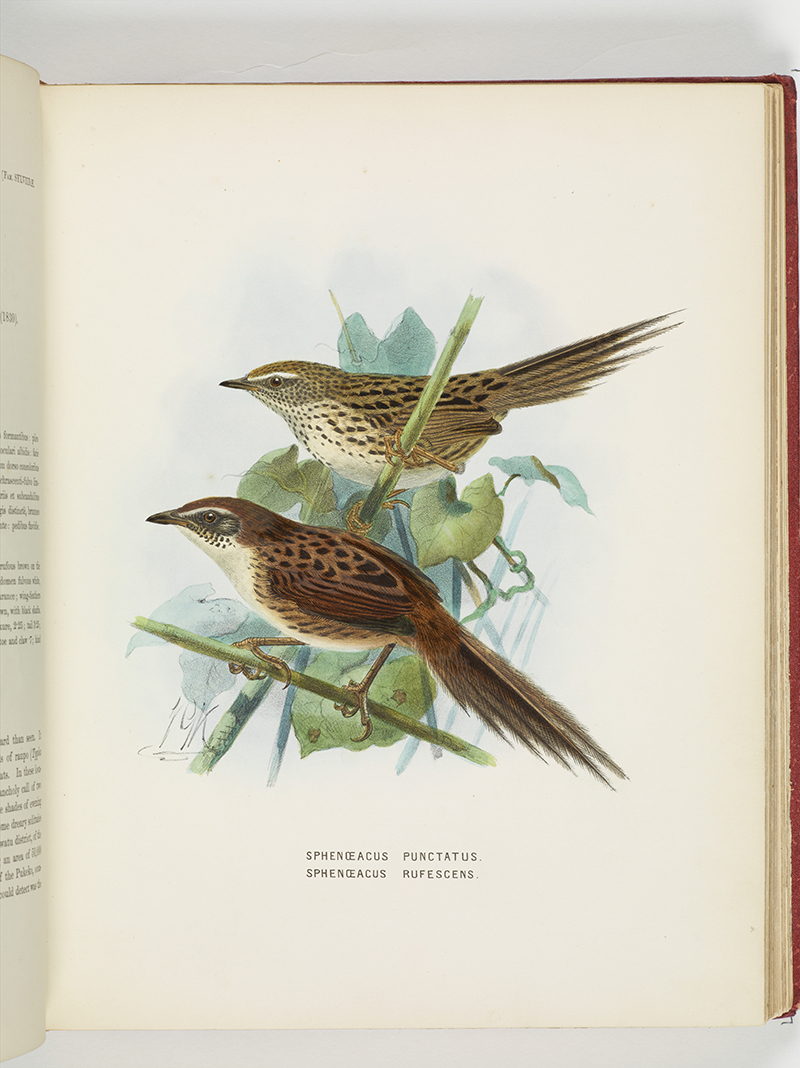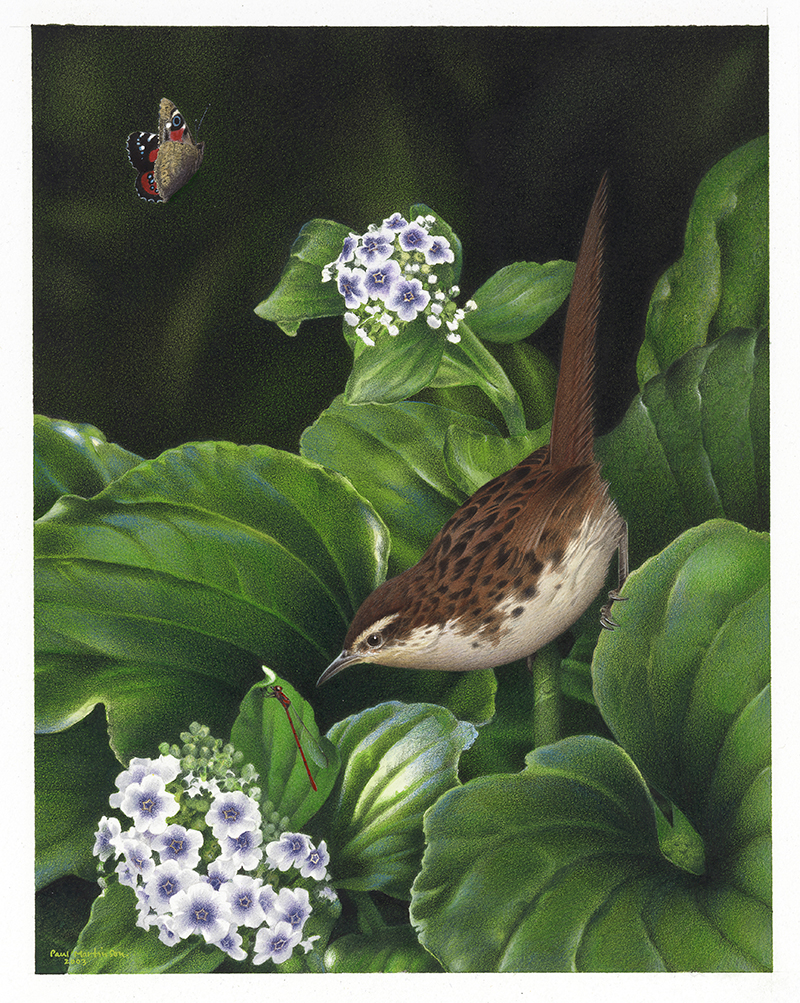Poodytes rufescens Buller, 1869:38
Chatham Islands fernbird
Taxonomy & Nomenclature
A complete synonymy taken from (Checklist Committee (OSNZ), 2022:223):
Sphenoeacus rufescens Buller, 1869: Ibis 5 (new series): 38 – Chatham Islands.; Megalurus rufescens (Buller); G.R. Gray 1869, Hand-list Birds 1: 206.; Bowdleria rufescens (Buller); Mathews & Iredale 1913, Ibis 1 (10th series): 445.; Bowdleria punctata rufescens (Buller); Checklist Committee 1953, Checklist N.Z. Birds: 62.; Megalurus punctatus rufescens (Buller); Dickinson 2003, Complete Checklist Birds World: 577.; Poodytes punctatus rufescens (Buller); Dickinson & Christidis 2014, Complete Checklist Birds World 2: 468.; Poodytes rufescens (Buller); del Hoyo & Collar 2016, Illustrated Checklist Birds World 2: 444.
Conservation Status
Extinct (Miskelly et al., 2022)
Last record: 1892; 1895 (Kittelberger et al., 2024); 1900 (Fleming, 1939); 1950-51 (Lindsay et al. 1959:104)
IUCN RedList status: Extinct
"CHATHAM ISLAND FERNBIRD. This species has been considered extinct for over 50 years. Mrs. G. Preece, of Pitt Island, reports seeing this bird on the south of Pitt Island about 1950-51."
(Lindsay et al. 1959:104)
Distribution
Pitt and Mangere Islands, Chatham Islands, New Zealand
Biology & Ecology
Hypodigm
Media

Above: Spenoeacus punctatus and Spenoeacus rufescens. Plate 14. From the book A history of the birds of New Zealand., 1873, by Johannes Keulemans. Te Papa (RB001176/014a)

Above: Chatham Island Fernbird. Bowdleria rufescens. From the series: Extinct Birds of New Zealand., 2003, Masterton, by Paul Martinson. Purchased 2006. © Te Papa. CC BY-NC-ND 4.0. Te Papa (2006-0010-1/7)
References
Original scientific description:
Other references:
Alström, P.; Cibois, A.; Irestedt, M.; Zuccon, D.; Gelang, M.; Fjeldså, J.; Andersen, M.J.; Moyle, R.G.; Pasquet, E. & Olsson, U. 2018. Comprehensive molecular phylogeny of the grassbirds and allies (Locustellidae) reveals extensive non-monophyly of traditional genera, and a proposal for a new classification. Molecular Phylogenetics and Evolution 127: 367–375.
BirdLife International. (2012). Bowdleria rufescens. In: IUCN 2012. IUCN Red List of Threatened Species. Version 2012.1. (http://www.iucnredlist.org). Downloaded on 19 August 2012.
BirdLife International. 2016. Poodytes rufescens. The IUCN Red List of Threatened Species 2016: e.T22728902A95000164. https://dx.doi.org/10.2305/IUCN.UK.2016-3.RLTS.T22728902A95000164.en. Accessed on 19 June 2022.
Brooks, T. 2000. Extinct species. In: BirdLife International (ed.), Threatened Birds of the World, pp. 701-708. Lynx Edicions and BirdLife International, Barcelona and Cambridge, U.K.
Checklist Committee (OSNZ). (2010). Checklist of the Birds of New Zealand, Norfolk and Macquarie Islands, and the Ross Dependency, Antarctica (4th ed.). Ornithological Society of New Zealand & Te Papa Press, Wellington. [p. 309]
Checklist Committee (OSNZ). (2022). Checklist of the Birds of New Zealand (5th edition). Ornithological Society of New Zealand Occasional Publication No. 1. Wellington: Ornithological Society of New Zealand. [p. 223]
Day, David. (1981). The Doomsday Book of Animals: A Natural History of Vanished Species. New York, N.Y.: The Viking Press.
del Hoyo, J., Collar, N.J., Christie, D.A., Elliott, A., Fishpool, L.D.C., Boesman, P. and Kirwan, G.M. 2016. HBW and BirdLife International Illustrated Checklist of the Birds of the World. Volume 2: Passerines. Lynx Edicions and BirdLife International, Barcelona, Spain and Cambridge, UK.
Fleming, C. A. (1939). Birds of the Chatham Islands. Emu 38: 380-413, 492-509.
Greenway James C. (1967). Extinct and Vanishing Birds of the World. American Committee for International Wild Life Protection, Special Publication no 13, 2nd edn. Dover Publications, New York.
Holdaway, Richard N., Worthy, Trevor H. and Tennyson, Alan J. D. (2001). A working list of breeding bird species of the New Zealand region at first human contact. New Zealand Journal of Zoology 28: 119-187.
Jouanin, Christian. (1962). Inventaire des oiseaux éteints ou en voie d’extinction conservés au Muséum de Paris. Terre et Vie 109: 275-301.
Kittelberger, Kyle D., Tanner, Colby J., Buxton, Amy N., Prewett, Amira and Şekercioğlu, Çağan Hakkı. (2024). Correlates of avian extinction timing around the world since 1500 CE. Avian Research 15: 100213. https://doi.org/10.1016/j.avrs.2024.100213 [Supplementary data (List of 216 taxa)]
Knox, Alan G. and Walters, Michael P. (1994). Extinct and endangered birds in the collections of The Natural History Museum. British Ornithologists' Club Occasional Publications 1: 1-292. [p. 217]
Lindsay, C. J., Phillipps, W. J. and Watters, W. A. (1959). Birds of Chatham Island and Pitt Island. Notornis 8(4): 99-106.
Millener, P.R. 1999. The history of the Chatham Islands’ bird fauna of the last 7000 years – a chronicle of change and extinction. Pp. 85–109. In: Olson, S.L. (Ed.). Avian paleontology at the close of the 20th Century. Proceedings of the 4th International meeting of the Society of Avian Paleontology and Evolution, Washington, D.C., 4–7 June 1996. Smithsonian Contributions to Paleobiology 89: i–viii + 1–344.
Miskelly, Colin M., Forsdick, Natalie J., Gill, Brian J., Palma, Ricardo L., Rawlence, Nicolas J. and Tennyson, Alan J. D. (2022). Amendments to the 2010 Checklist of the birds of New Zealand. Ornithological Society of New Zealand Occasional Publication No. 2. Wellington: Ornithological Society of New Zealand.
Olson, Storrs L. (1990). Osteology and systematics of the fernbirds (Bowdleria: Sylviidae). Notornis 37: 161-171.
Robertson, H. A., Baird, K. A., Elliott, G. P., Hitchmough, R. A., McArthur, N. J., Makan, T. D., Miskelly, Colin M., O’Donnell, C. F. J., Sagar, P. M., Scofield, R. P., Taylor, G. A. and Michel, P. (2021). Conservation status of birds in Aotearoa New Zealand, 2021. New Zealand Threat Classification Series 36. Department of Conservation, Wellington. 43 pp.
Hugh Robertson, John Dowding, Graeme Elliott, Rod Hitchmough, Colin Miskelly, Colin O’Donnell, Ralph Powlesland, Paul Sagar, Paul Scofield, Graeme Taylor. (2013). Conservation status of New Zealand birds, 2012. New Zealand Threat Classification Series 4. 22 pp.
Rothschild, Lionel Walter (1907). Extinct birds: an attempt to write in one volume a short account of those birds which have become extinct in historical times, that is within the last six or seven hundred years: to which are added a few which still exist, but are on the verge of extinction. London: Hutchinson & Co. XXIX + 243 pp. [p. 21, pl. 5]
Sayol, Ferran, Steinbauer, Manuel J., Blackburn, Tim M., Antonelli, Alexandre and Faurby, Søren. (2020). Anthropogenic extinctions conceal widespread evolution of flightlessness in birds. Science Advances 6(49): eabb6095. https://doi.org/10.1126/sciadv.abb6095 [Supplementary Material (Data File S1)]
Tennyson, Alan J. D. and Bartle, J. A. (2008). Catalogue of type specimens of birds in the Museum of New Zealand Te Papa Tongarewa. Tuhinga 19: 185-207.
Tennyson, Alan J. D. and Martinson, Paul. (2006). Extinct Birds of New Zealand. Wellington: Te Papa Press.
Tennyson, A.J.D. & Millener, P.R. 1994. Bird extinctions and fossil bones from Mangere Island, Chatham Islands. Notornis 41(Supplement): 165–178.
Travers, H. H. and Travers, W. T. L. (1872). On the birds of the Chatham Islands, with introductory remarks on the avifauna and flora of the islands in their relation to those of New Zealand. Transactions and Proceedings of the New Zealand Institute 5: 212-222.
Turbott, E.G. 1990. Checklist of the Birds of New Zealand. Ornithological Society of New Zealand, Wellington.
Tyrberg, Tommy. (2009). Holocene avian extinctions, pp. 63-106. In: Turvey, Samuel T. (ed.). Holocene Extinctions. Oxford, UK & New York, USA: Oxford University Press. xii + 352 pp.
Williams, G. R. (1962). Extinction and the land and freshwater-inhabiting birds of New Zealand. Notornis 10(1): 15-32.
Worthy, Trevor H. and Holdaway, Richard N. (2002). The Lost World of the Moa: Prehistoric Life of New Zealand. Bloomington, Indiana: Indiana University Press. xxxiii + 718 pp.
